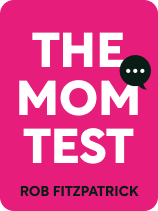

This article is an excerpt from the Shortform book guide to "The Mom Test" by Rob Fitzpatrick. Shortform has the world's best summaries and analyses of books you should be reading.
Like this article? Sign up for a free trial here.
Why should you gather customer feedback? What do you do with that feedback?
Feedback is important in any workplace, but especially important if you have a new idea you want to test. Rob Fitzpatrick’s book The Mom Test suggests five ways to gather feedback from customers that will determine if you have a great idea on your hands.
Keep reading to learn how to gather customer feedback with Fitzpatrick’s five strategies.
1. Listen More Than You Talk
Fitzpatrick’s first recommendation to gather customer feedback is to listen more than you talk. Recall that you want an unfiltered view of the customer’s life. The less you talk about yourself and what you want to hear from the customer, the less biased their self-descriptions will be. If you follow Rule #1 and avoid pitching your idea, this rule should be easy to follow.
(Shortform note: Fitzpatrick’s third rule of the Mom Test shows us that introverts, who tend to be better listeners, may be more suited to engage in feedback conversations with customers than extroverts. This runs contrary to the popular assumption that you must be a charismatic extrovert to be a world-class business leader. In reality, many of history’s most successful businesspeople have been introverts, including Bill Gates and Charles Schwab. So, if you’re an introverted entrepreneur, know that this is a strength, not a weakness.)
Now that we’ve explained what the Mom Test is and how to use it to get valuable feedback from discussions with customers, let’s explore how to use these conversations to support your business. Fitzpatrick advises you to approach discussions with customers in slightly different ways depending on the stage your business is in: First, before you have a product, use the Mom Test to gather information about your customers. Second, once you have a product, advance your business by getting potential customers to commit to it. Let’s inspect each of these two stages in turn.
2. Settle on Three Learning Objectives for Your Conversation
Once you’ve chosen a target audience, Fitzpatrick advises identifying the three most important things you’d like to learn by talking to these customers. Use these objectives to keep your conversations focused. For example, if you’re planning to sell e-readers, your three learning objectives may be to 1) find out if customers really are dissatisfied with the way they currently read books, 2) figure out what has kept them from buying an e-reader in the past, and 3) discover what is motivating your customers to read books in the first place.
As you gather information from your potential customers, you’ll need to continuously update your learning objectives. Adjust your learning goals to fill gaps in your knowledge until you fully understand your customers’ motivations, problems, and daily routines.
3. Good Learning Objectives Serve a Higher Purpose
What differentiates a good learning objective from a bad one? According to Angela Duckworth in Grit, good goals always contribute toward a specific “higher” goal. For example, you might set the goals to eat healthy foods and get sufficient sleep to feel more energized, and you might seek more energy so you can effectively build your business. Thus, a helpful way to brainstorm learning objectives is to identify your higher goal and list all the things you need to learn to achieve it. If you come up with a long list of sub-goals, paring it down to three objectives, as Fitzpatrick suggests, will ensure you focus your efforts enough to make progress.
Duckworth’s framework also reveals that you’ll need to update your learning objectives not only after you achieve them, but also as your higher-level goals change. For example, when you stop gathering information and start pitching your product to customers (as we’ll discuss later), you’ll stop asking questions like “What do our customers’ daily habits look like?” and start asking questions like “What is our customers’ biggest fear dissuading them from buying our product?”
4. Take Notes During Discussions With Customers
Fitzpatrick asserts that another important aspect of gathering customer feedback is taking notes. By recording and organizing the information you learn, you’ll have an easier time accurately recalling past conversations and keeping your other team members informed.
Fitzpatrick advises having a designated note-taker at most meetings so you don’t have to take notes and run the meeting at the same time. In addition, write down direct quotations when possible. Not only do quotes help you be objective when referring back to your notes, but they can also later be used for marketing and fundraising.
(Shortform note: Taking notes doesn’t just help you in the long run, as Fitzpatrick states—it also helps you stay engaged during the conversation itself. The process of taking notes keeps you alert and focused on what the customer is saying. If you normally have trouble staying focused, you may consider taking notes yourself rather than designating a note-taker. Another way you can make your note-taking more active is by rephrasing the conversation in your own words instead of copying down exact quotations as Fitzpatrick recommends. This will help you process what you’re learning and spark creative new ideas.)
5. Never Stop Seeking Feedback
Fitzpatrick advises that you continue to seek feedback from customers as needed throughout the lifespan of your company. Once your product is a proven success, you won’t have to spend as much time talking to customers as when you’re first starting out, but it’s helpful to maintain an ongoing stream of feedback as your business continues to grow.
(Shortform note: It’s important to never stop seeking feedback because companies often lose touch with what their customers want after achieving success. In Good Strategy/Bad Strategy, Richard Rumelt explains that these companies lose touch with customers because of the twin forces of inertia and entropy: People in any organization will default to doing things the way they’ve always been done, even if it’s no longer effective (inertia), and organizations become more disorganized over time unless they’re actively managed (entropy).)

———End of Preview———
Like what you just read? Read the rest of the world's best book summary and analysis of Rob Fitzpatrick's "The Mom Test" at Shortform.
Here's what you'll find in our full The Mom Test summary:
- How to ask the right questions to receive brutal honesty from anyone—even your mom
- How to use the “Mom Test” to gather objective feedback about your business or product
- How to extract the most important information from feedback conversations






